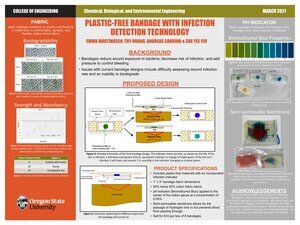
Adhesive bandages are intended to cover and protect wounds from further harm. They hold cuts together, control fluid secretions and provide a barrier against environmental factors. According to the Center for Disease Control and Prevention (CDC), nearly 270,000 Americans died from the life-threatening disease of sepsis in the year of 2020. Covering wounds with bandages, however, significantly diminishes the chances of uncontrolled microbial proliferation, which can therefore lower the likelihood of these complications. Adhesive bandages are made of a flexible sheet of material that adheres to the skin. The sticky side of the bandage has a non-sticky, absorbent pad which covers the wound. Current bandage creations exist in a myriad of shapes, sizes and colors that adhere to unique customer needs. Moreover, some include advanced qualities that incorporate water resistance and healing ointments. Despite the many benefits current bandages on the market provide, opportunities for improvement are still abundant.
Current bandage designs make it hard for the user to detect an infection. Since the product’s main objective is to cover lesions, determining which healing stage the wound is in can be difficult to discern. On top of this, most bandages are not environmentally friendly. There are many designs that contain plastics, amongst other non-degradable materials.
To address these issues, we have designed a plastic-free bandage with infection detection technology. Our bandage backing is made of a biodegradable cotton-hemp fabric that is durable, comfortable, sufficient at wicking away water, and can be easily manipulated in terms of color. The absorbent cotton pad contains a small amount of Bromothymol blue in a neutral solution which serves as the infection indicator. Bromothymol blue will start off green and turns turquoise when exposed to blood, which has a pH of around 7.3 - 7.5. When the wound becomes infected, and its pH becomes greater than 8.0, the indicator will turn blue. This color indicator will make it abundantly clear to the user when their wound is infected. This way, they are able to make an educated and quick conclusion when deciding on a treatment option.
Our bandage is different from any other product on the market due to its infection detection technology and its biodegradable properties. We believe our bandage design will be well received by consumers, competitive with respect to other adhesive bandages, and extremely profitable.
| Attachment | Size |
|---|---|
| 55.8 KB | |
| 51.57 KB | |
| 50.98 KB |

